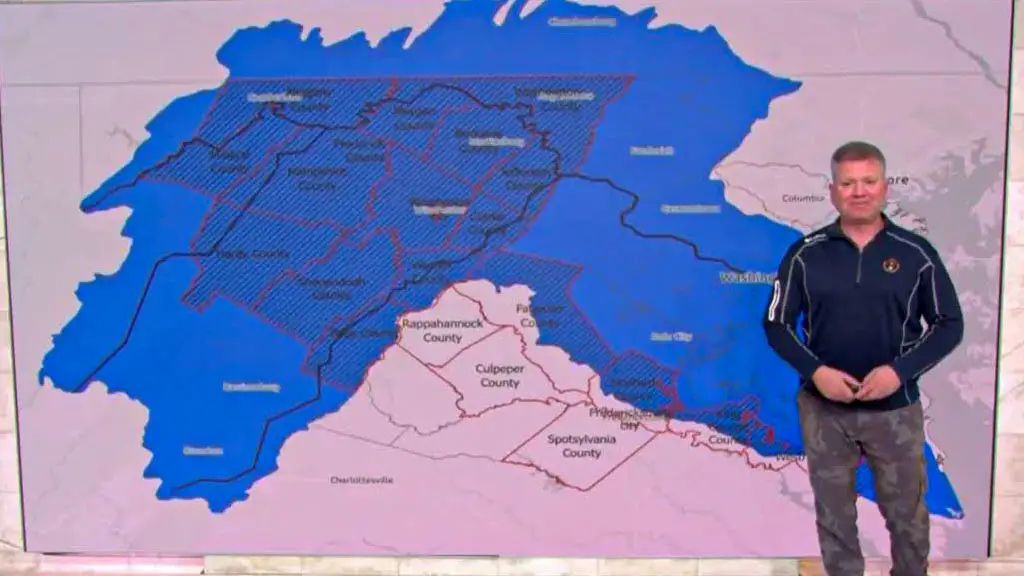Washington DC, known for its iconic monuments and political significance, may seem like an unlikely target for hurricanes. However, as climate patterns evolve, the possibility of these powerful storms affecting the nation’s capital cannot be ruled out.
While Washington DC is not located directly on the coast like traditional hurricane-prone areas, it is not immune to the potential impacts of these natural disasters.
Despite its inland location, Washington DC has experienced the effects of hurricanes in the past, with heavy rainfall, strong winds, and flooding posing significant challenges to the city and its infrastructure.
As climate change continues to influence weather patterns, the risk of hurricanes making their way to the capital region may increase.
Understanding the potential threat of hurricanes in Washington DC is crucial for preparedness and resilience in the face of these extreme weather events.

Historical Impact of Hurricanes on Washington DC
Washington DC, although not situated directly on the coast, has faced the repercussions of hurricanes over the years. The city has encountered heavy rainfall, strong winds, and flooding from these tropical storms.
Major Hurricanes and Their Consequences
Here’s an overview of some major hurricanes and their consequences in different regions:
Hurricane Isabel (2003)

In September 2003, Hurricane Isabel caused significant damage in Washington DC. The storm brought strong winds and heavy rainfall, leading to widespread power outages and flooding in various parts of the city.
Given Washington DC’s susceptibility demonstrated by Hurricane Isabel in 2003, it is evident that the region can indeed suffer from hurricanes, impacting infrastructure and residents alike.
Hurricane Sandy (2012)

While not a direct hit, Hurricane Sandy’s impacts were felt in Washington DC. The storm brought heavy rain and strong winds, causing disruptions in the region and highlighting the vulnerability of the capital to such extreme weather events.
Hurricanes can pose a risk to Washington DC due to its susceptibility to heavy rain and strong winds. Although not a common occurrence, events like Hurricane Sandy have shown the potential impact and vulnerability of the capital to such extreme weather conditions.
Infrastructure Damage
Hurricanes have often resulted in damage to Washington DC’s infrastructure, including roads, bridges, and public buildings. The long-term impact of these storms can strain resources for repairs and rebuilding efforts, affecting the city’s overall infrastructure resilience.
Hurricanes can indeed pose a threat to Washington DC’s infrastructure due to the potential damage inflicted on roads, bridges, and public buildings.
The lasting consequences of such storms can stretch resources for restoration and reconstruction, impacting the city’s infrastructure resilience significantly.
Economic Consequences
The economic fallout from hurricanes can be substantial for Washington DC. Businesses may suffer losses due to disruptions in operations, while the cost of recovery and rebuilding can place a strain on the city’s budget, impacting its economy in the long run
Additionally, the infrastructure damage caused by hurricanes can further hinder the city’s development and growth, necessitating significant investments in repairs and reinforcement to mitigate future risks and ensure resilience against future natural disasters.
Geographical Susceptibility of Washington DC to Hurricanes

Washington DC, despite being inland, exhibits geographical factors that make it susceptible to hurricanes and tropical storm impacts:
Washington DC’s Location and Weather Patterns
Located on the East Coast of the United States, Washington DC’s geographical position exposes it to potential hurricane impacts despite being inland.
The city’s proximity to the Atlantic Ocean makes it susceptible to the effects of tropical storms that can travel inland, bringing heavy rainfall, strong winds, and the risk of flooding.
While Washington DC is not directly on the coast, its vulnerability to hurricanes stems from its proximity to the Atlantic Ocean. The city can still experience significant impacts from tropical storms, including heavy rainfall and strong winds, leading to potential flooding.
Proximity to Water Bodies
Washington DC’s proximity to water bodies, such as the Potomac River and the Chesapeake Bay, further amplifies its vulnerability to hurricanes.
These water sources can contribute to increased moisture in the air, creating favorable conditions for the intensification of storms and enhancing the risk of flooding within the city.
As a result, Washington DC can indeed suffer from hurricanes, especially when these powerful storms make landfall in the region.
The combination of geographic factors and environmental conditions makes the city susceptible to the impacts of hurricanes, including strong winds and heavy rainfall.
How Washington DC Prepares for Hurricanes

Washington DC takes several proactive steps to prepare for hurricanes and mitigate their potential impacts. Here are key aspects of the city’s preparedness efforts:
Emergency Response Strategies
When it comes to handling hurricanes, Washington DC has a well-structured emergency response plan in place.
The city’s emergency management agencies work closely with local authorities, including the Metropolitan Police Department and the Fire and Emergency Medical Services Department, to coordinate disaster response efforts.
They conduct regular drills and exercises to ensure readiness for any potential hurricane threats.
With its robust emergency response plan and collaboration among various local authorities, Washington DC is well-prepared to handle hurricanes due to regular drills and exercises that enhance readiness levels for potential threats.
Community Awareness and Preparedness Programs
Washington DC places a strong emphasis on community awareness and preparedness when it comes to hurricanes.
The city actively engages with residents through various outreach programs, educational campaigns, and workshops to educate them about hurricane risks and the necessary precautions to take.
Community members are encouraged to develop personal emergency plans, assemble disaster supply kits, and stay informed through local news and official updates.
This proactive approach ensures that the community is well-prepared and can respond effectively in the event of a hurricane.
Protecting Yourself During a Hurricane in Washington DC

When preparing for a hurricane in Washington DC, it’s crucial to follow safety measures and have emergency kits ready. These steps can significantly help in ensuring personal safety and readiness during a storm.
Safety Measures
To stay safe during a hurricane, secure outdoor items to prevent them from becoming dangerous in strong winds. Stay inside, away from windows, to avoid injuries from broken glass or debris. Have emergency supplies such as food, water, and a first aid kit on hand.
Avoid using candles to prevent fires in case of gas leaks. Keep in mind that Washington DC does not frequently experience hurricanes, but it is still important to be prepared for all types of emergencies.
Following these safety tips can protect yourself and your loved ones during severe weather events.
Emergency Kits
Prepare an emergency kit with necessities like food, water, medications, first aid supplies, flashlight, batteries, and important documents. Keep it easily reachable and in a waterproof container.
Stay informed during hurricanes with reliable sources and secure your home by reinforcing doors and windows. Consider creating a communication plan with your family and a designated meeting point in case of evacuation.
Follow local authorities’ instructions and evacuate if necessary to ensure your safety during a hurricane in Washington DC.
Evacuation Routes
To prepare for a potential evacuation in Washington DC, know the designated routes, follow official instructions promptly, and have an emergency kit with essentials ready. Stay updated with reliable sources for current updates on the hurricane situation.
Remember to secure outdoor furniture and loose objects to prevent damage during high winds. Keep important documents and valuables in a waterproof container as part of your emergency kit.
Stay informed through local news and official weather channels for the latest updates.
Shelters
It is important to know the locations of emergency shelters in Washington DC to seek refuge during a hurricane evacuation. Having a plan in place beforehand to reach these shelters safely is crucial for a smooth evacuation process.
Familiarizing yourself with nearby shelters in advance will help ensure a safe and efficient evacuation if the need arises.
Additionally, staying informed about evacuation routes and procedures provided by local authorities can further aid in navigating to the designated shelters during a hurricane.
Being prepared and proactive is key to keeping yourself and your loved ones safe in times of emergencies.
Frequently Asked Questions
How vulnerable is Washington DC to hurricanes?
Washington DC is vulnerable to hurricanes due to its East Coast location near the Atlantic Ocean, Potomac River, and Chesapeake Bay. Hurricanes like Isabel in 2003 and Sandy in 2012 have highlighted the city’s susceptibility to these natural disasters.
What safety measures are important during hurricanes in Washington DC?
Safety measures during hurricanes in Washington DC include securing outdoor objects, staying indoors during storms, and having emergency kits prepared.
Knowing evacuation routes, following local authorities’ guidance, and identifying nearby shelters are crucial for ensuring safety during hurricanes.
Does Washington DC have a well-structured emergency response plan for hurricanes?
Yes, Washington DC has a well-structured emergency response plan in place for hurricanes. The city emphasizes community awareness efforts and personal preparedness to ensure an effective response to hurricanes.
Residents are encouraged to stay informed and prepared for potential hurricane threats.
Conclusion
To conclude, preparing for hurricanes in Washington DC is essential for the safety and well-being of its residents. Securing outdoor objects, staying indoors during storms, and having emergency kits with essentials are key steps in staying safe when hurricanes strike.
Knowing evacuation routes, following local authorities’ guidance, and identifying nearby shelters for refuge are crucial actions to take in the face of a hurricane threat.
Additionally, staying informed through weather updates and alerts from official sources can help residents make timely decisions and respond effectively to changing conditions during a hurricane in Washington DC.
It’s also important to have a communication plan in place with loved ones and neighbors to stay connected and support each other during and after a hurricane.
Regularly reviewing and updating your emergency preparedness efforts can further ensure readiness for any potential hurricane impact in Washington DC.




Allison Brice